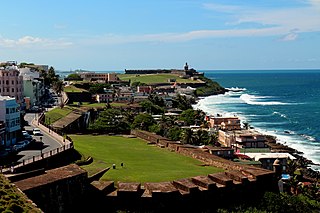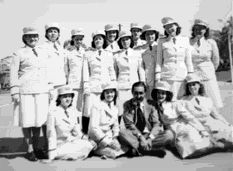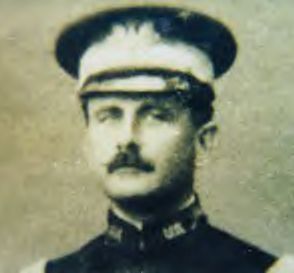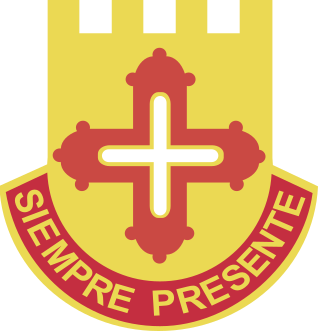| Fort Brooke | |
|---|---|
| Old San Juan, Puerto Rico | |
| Type | U.S. Army Post 851 |
| Site information | |
| Controlled by | United States |
| Garrison information | |
| Garrison | DEML DETACHMENT |
Fort Brooke was a United States Army post established on 3 March 1943 under General Order Number 10 [1] during World War II after the German U-boat attacks of 1942 on the Caribbean Basin in conjunction to Operation Z.
During the early years, Puerto Rico played a leading role as the operations center in the Antilles Screen against German U-boats, whose attacks reached an alarming peak in 1942 with the sinking of 336 ships in the Caribbean area. Ships sailing from South American ports carried such strategic products as gasoline, oil derivatives, and bauxite for aluminum production, and their losses were serious. Puerto Rico provided support for U.S. naval forces charged with controlling the Caribbean; it served as a base for air protection for ships, other outposts in the region, and the approaches to the Panama Canal; and it was an important link in the transport and ferrying route for aircraft, personnel, and cargo going to Africa and Middle East. [2]
In May 1942, U-boats sunk 56 ships totaling more than 248,000 tons of shipment in the space of 4 months all throughout the Caribbean Sea Frontier west of the shipping control line. By the middle of the month, 22% of the bauxite fleet had been destroyed, 20% of the ships in the Puerto Rican run had been lost, and of 74 vessels allocated to the Army for the month of 17 July had already been sunk. [3]
Anxious at the beginning of World War II to avoid raising fears of the U.S. expansion in the hemisphere through the creation of military bases in Latin America, President Roosevelt concentrated instead on strengthening defenses at both ends of the U.S. Canal Zone, and establishing an air base and other military installations on the island of Puerto Rico, the major U.S. territory in the Caribbean Basin. [4]
In the President's opinion, expressed in a bill that failed to pass in the U.S. Senate in 1943, the chain of islands running in a great arc from New Orleans to the shoulder of South America, enclosing the Caribbean Basin, formed a vast natural shield for the Panama Canal, suited in distance and conformation to the uses of the military plane. And of this island shield, Puerto Rico is the center. [5]
General Order No. 10 read:
The Headland Castle at Old San Juan will be named Fort Brooke in memory of United States Army Major General John Rutter Brooke from Pennsylvania, better known as "John Ruller" during the American Civil War between 1861 and 1865 and the Spanish–American War of 1898.
Fort Brooke was located in Fort San Felipe del Morro, a Spanish colonial fort. It consisted of offices for technicians, observers, military staff and police, music band members, motor pool workers and medical personnel. Officers' quarters were constructed along the road leading to the Castle surrounded by an Officers' Club, one swimming pool, the Bachelor Officers' Quarters (BOQ) and one outdoor cinema on top of a golf course. Observation posts, communications centers and underground installations were also added in the sector. [6]
Due to declining maritime losses in the Atlantic as the war progressed, the base saw little action in the later war years, and became home to a number of sporting and leisure activities. [7]
On 31 August 1944, the United States Department of War issued General Order No. 71 which transformed the Ballajá station into the Fort Brooke Hospital installation.
Puerto Ricans drafted to the United States Armed Forces during the Korean War and the Vietnam War reported to the Armed Forces Examination and Induction Station (AFEIS) at Fort Brooke for screens and processes before being sent to active duty. In 1970 Armed Forces Examination and Induction Station at Fort Brooke was redesignated as the Armed Forces Examining and Entrance Station. In 1978 the station moved to a new facility in Guaynabo, Puerto Rico near the Fort Buchanan Army base and became a Military Entrance Processing Station (MEPS). On 1 January 1982, the center was redesignated as MEPS San Juan. In 2013 the Military Entrance Processing Station moved to a new location at Millennium Park Plaza in Guaynabo.
The military defense of Puerto Rico is the responsibility of the United States as part of the Treaty of Paris. Locally, Puerto Rico has its own National Guard, the Puerto Rico National Guard, and its own state defense force, the Puerto Rico State Guard, which, by local law, is under the authority of the Puerto Rico National Guard. The commander-in-chief of both forces is the governor of Puerto Rico, currently Pedro Pierluisi, who delegates his authority to the Puerto Rico Adjutant General, currently Major General José J. Reyes. The Adjutant General, in turn, delegates the authority over the State Guard to another officer but retains the authority over the Puerto Rico National Guard as a whole. At the national level, the commander-in-chief is the President of the United States, currently Joe Biden.

San Juan is the capital city and most populous municipality in the Commonwealth of Puerto Rico, an unincorporated territory of the United States. As of the 2020 census, it is the 57th-largest city under the jurisdiction of the United States, with a population of 342,259. San Juan was founded by Spanish colonists in 1521, who called it Ciudad de Puerto Rico.

United States Army Garrison Fort Buchanan, is a United States Army installation in Puerto Rico. It is located in the metropolitan area of the capital, San Juan.

Castillo San Felipe del Morro, also known as El Morro, is a citadel built between 16th and 18th centuries in San Juan, Puerto Rico.

Castillo San Cristóbal is a fortress in San Juan, Puerto Rico. It was built by the Spanish to protect against land-based attacks on the city of San Juan. It is part of San Juan National Historic Site.

Old San Juan is a historic district located at the "northwest triangle" of the islet of San Juan in San Juan. Its area roughly correlates to the Ballajá, Catedral, Marina, Mercado, San Cristóbal, and San Francisco sub-barrios (sub-districts) of barrio San Juan Antiguo in the municipality of San Juan, Puerto Rico. Old San Juan is the oldest settlement within Puerto Rico and the historic colonial district of the city of San Juan. This historic district is a National Historic Landmark District and is listed on the United States National Register of Historic Places as the Old San Juan Historic District. Several historical buildings and structures, particularly La Fortaleza, the city walls, and El Morro and San Cristóbal castles, have been inscribed in the UNESCO World Heritage Site list since 1983. Historically the mixed use commercial and residential real estate in the main streets like Cristo Street, Fortaleza Street (north) from Tanca Street to the Governor’s Mansion is the most valuable in the area and it has kept its value and increased steadily through several years despite the past economic turmoils.

Irish immigration to Puerto Rico began during the period of Spanish colonization of the island, continuing through 19th century to the present day. During the 16th century, many Irishmen, who were known as "Wild Geese", deserted from the English Army and joined the Spanish Army. They did so either in Europe or when they could "jump ship" off the coast of Puerto Rico, at which time they joined the Spanish colonial army, mainly in San Juan.

Roosevelt Roads Naval Station, nicknamed Rosy Roads, is a former United States Navy base in the town of Ceiba, Puerto Rico. The site operates today as José Aponte de la Torre Airport, a public use airport.

The recorded military history of Puerto Rico encompasses the period from the 16th century, when Spanish conquistadores battled native Taínos in the rebellion of 1511, to the present employment of Puerto Ricans in the United States Armed Forces in the military campaigns in Afghanistan and Iraq.

Lieutenant Colonel Teófilo Marxuach,, was the person who ordered the first shots fired in World War I on behalf of the United States on an armed German supply ship trying to force its way out of the San Juan Bay. Marxuach ordered hostile shots from a machine gun and a cannon located at the Santa Rosa battery of "El Morro" fort, in what is considered to be the first shots of World War I fired by the regular armed forces of the United States against any ship flying the colors of the Central Powers, forcing the Odenwald to stop and to return to port, where its supplies were confiscated.

Major Fernando E. Rodríguez Vargas, DDS was an odontologist (dentist), scientist and a Major in the U.S. Army who discovered the bacteria which causes dental caries.
Two of the least-known roles played by Puerto Rican women and women of Puerto Rican descent have been that of soldier and that of revolutionary. This is a brief account of some the Puerto Rican women who have participated in military actions as members of either a political revolutionary movement or of the Armed Forces of the United States.

The Puerto Rico National Guard (PRNG) –Spanish: Guardia Nacional de Puerto Rico– is the national guard of the U.S. Commonwealth of Puerto Rico. The Constitution of the United States specifically charges the National Guard with dual federal and state missions, which includes to provide soldiers and airmen to the United States Army and U.S. Air Force in national emergencies or when requested by the president of the United States, and to perform military operations at the state level or any other lawful service as requested by the governor of Puerto Rico. The PRNG responds to the governor of Puerto Rico, who serves as its commander in chief and imparts orders with the Puerto Rico adjutant general acting as conduit, and its local mission is to respond as requested in military or civilian tasks. Abroad, its main function is to train a reserve capable of providing additional personnel in a war scenario.

Puerto Ricans and people of Puerto Rican descent have participated as members of the United States Armed Forces in the American Civil War and in every conflict which the United States has been involved since World War I. In World War II, more than 65,000 Puerto Rican service members served in the war effort, including the guarding of U.S. military installations in the Caribbean and combat operations in the European and Pacific theatres.

Juan de Amézqueta, was a captain in the Puerto Rican Militia who defended Puerto Rico from an invasion by the Dutch in 1625. He fought and wounded Captain Balduino Enrico who was ordered by the Dutch Government to capture Puerto Rico.
Puerto Ricans and people of Puerto Rican descent have participated as members of the United States Armed Forces in every conflict in which the United States has been involved since World War I.

The 65th Infantry Regiment, nicknamed "The Borinqueneers" during the Korean War for the original Taíno Indian name for Puerto Rico (Borinquen), is a Puerto Rican regiment of the United States Army. The regiment's motto is Honor et Fidelitas, Latin for Honor and Fidelity. The Army Appropriation Bill created by an act of Congress on 2 March 1899 authorized the creation of the first body of native troops in Puerto Rico. On 30 June 1901, the "Porto Rico Provisional Regiment of Infantry" was organized. On 1 July 1908, Congress incorporated the regiment into the Regular Army as the Puerto Rico Regiment of Infantry, United States Army. On 14 May 1917, the regiment was activated and additional men were assigned, with the unit being sent to serve at Panama. On 4 June 1920, the regiment was renamed 65th Infantry. During World War II, the regiment saw action throughout Europe, especially France and Germany, participating in Naples-Foggia, Rome-Arno and Rhin. Several Purple Hearts were awarded posthumously to members of the 65th Regiment.

Fort Allen, officially Fort Allen Training Center, is a Puerto Rico National Guard military installation located on a 921-acre facility in Juana Díaz, Puerto Rico.

Camp Las Casas was a United States military installation established in Santurce, Puerto Rico in 1904. The camp was the main training base of the "Porto Rico Regiment of Infantry," a segregated U.S. Army Regiment which was later renamed the "65th Infantry Regiment." The base continued in operation until 1946, when it was closed.
{{cite web}}: Missing or empty |url= (help)